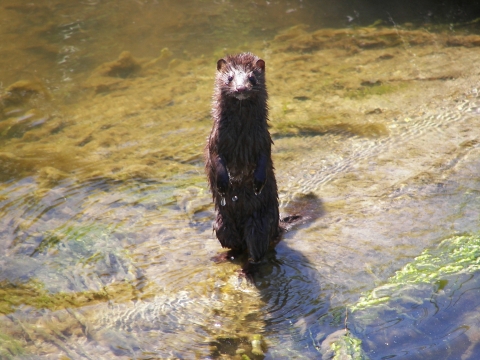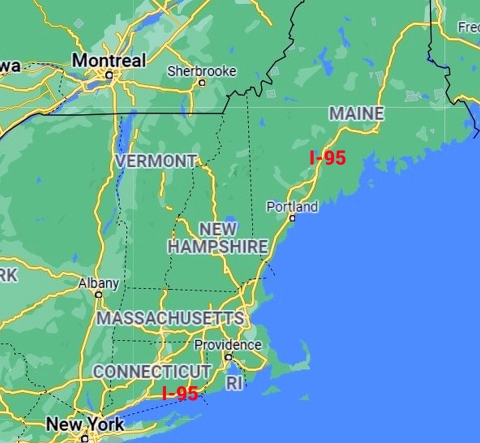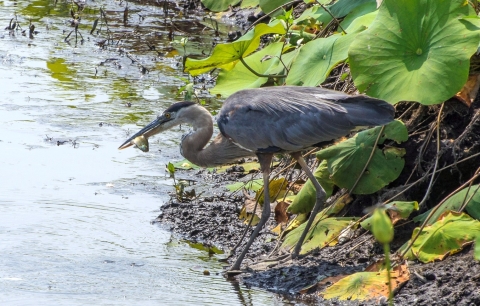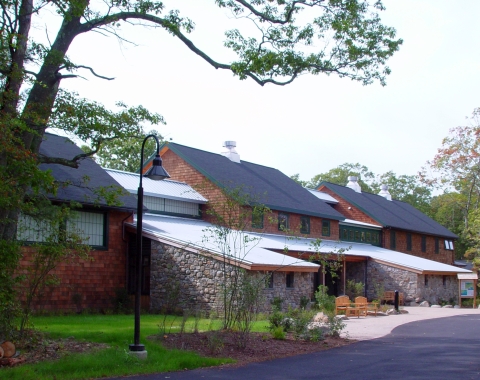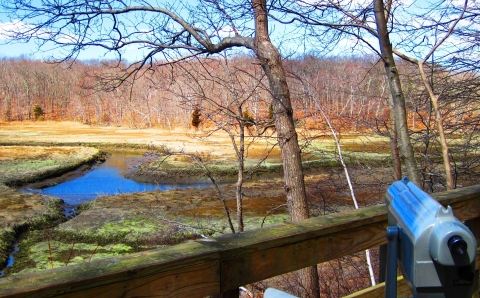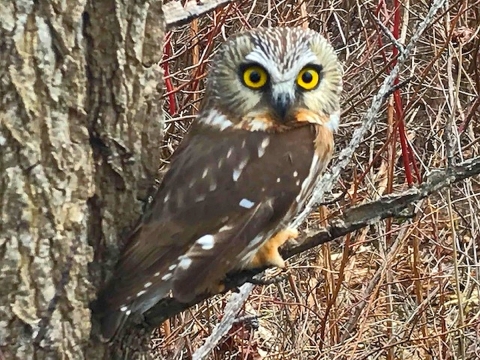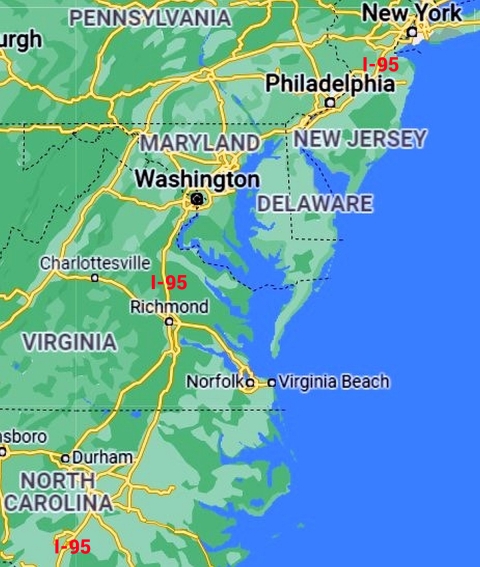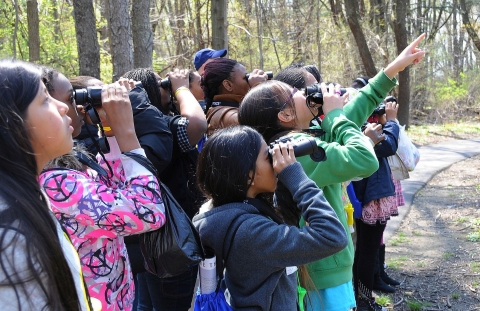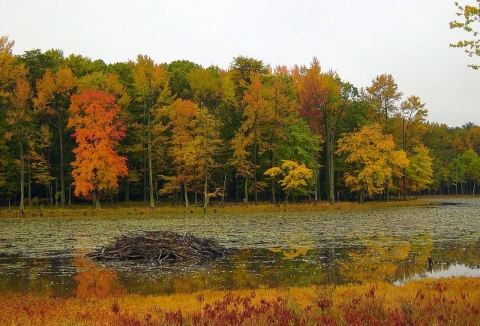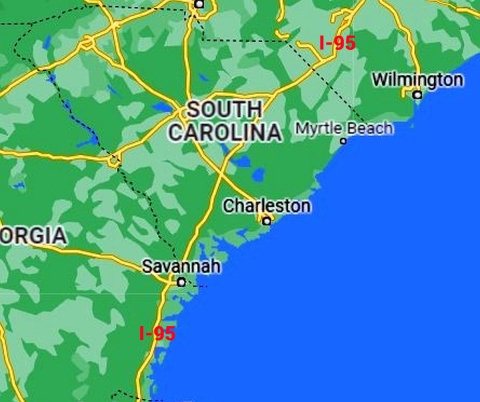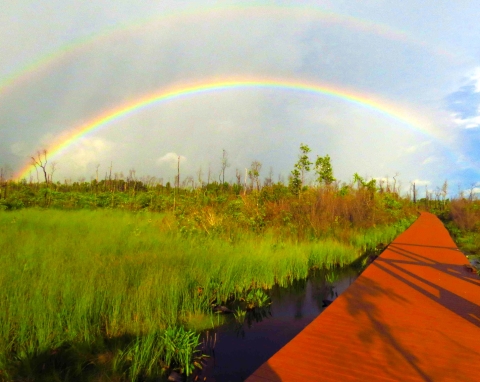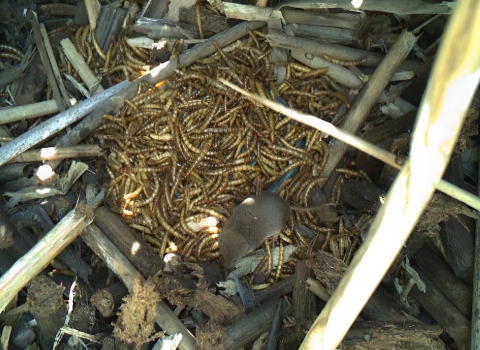Interstate 95 is the East Coast’s primary north-south road. It runs 1,919 miles from Houlton, Maine, on the Canadian border to just south of downtown Miami, Florida. This story presents a state-by-state glance at national wildlife refuges where travelers seeking a nature break might stop along the way. It includes expert tips about what a visitor might do and see during a one-hour stop at each refuge.
Maine
Sunkhaze Meadows National Wildlife Refuge
(10 miles east of Exit 193 near Milford)
“If I had just one hour – and no more – I would walk out to the Carter Meadow platform hoping to spy a moose out in the bog or hear the thunder-pumping call of an American bittern,” says Danielle D’Auria, president of the Friends of Sunkhaze Meadows National Wildlife Refuge. “It would be late May when the birds are back and singing and moose are hungry for tender greens.”
Rachel Carson National Wildlife Refuge
(4 miles from Exit 19 just north of Wells)
“I would walk the mile-long Carson Trail – located at 321 Port Road – in mid-to-late spring to look for ephemeral wildflowers and migratory songbirds,” says assistant refuge manager Ryan Kleinert. “The trail borders tidal creeks and offers impressive vantage points of the salt marsh salt marsh
Salt marshes are found in tidal areas near the coast, where freshwater mixes with saltwater.
Learn more about salt marsh .”
New Hampshire
Great Bay National Wildlife Refuge
(3 miles west of Exit 3, in Newington)
“I would walk along the fully accessible .25 mile-long Upper Peverly Pond Boardwalk, where an observation deck at the edge of the pond provides an opportunity to see osprey, great blue heron, beaver, painted turtles and perhaps even an American bald eagle,” says visitor services manager Matt Poole.
Massachusetts
Parker River National Wildlife Refuge
(8 miles east of Exit 57 near Newburyport)
“I would head for Parking Lot 4, where the popular Hellcat Trail Boardwalk provides opportunities for seeing native wildlife in marsh, maritime forest and dune habitat,” says visitor services manager Matt Poole. “Hellcat is a particularly hot spot for viewing migrating songbirds during the spring and fall migrations.”
Assabet River National Wildlife Refuge
(12 miles west of Exit 26 in Sudbury)
“I’d check out the exhibits in our visitor center, and then make the 15-minute walk down the Winterberry Way and Carbary’s trails to the fishing pier on Puffer Pond,” visitor services manager Jared Green says. “The visitor center is great for families. It offers fun interactive exhibits, and the fish are always biting from the fishing pier.”
Great Meadows National Wildlife Refuge
(10 miles west of Exit 26 in Sudbury)
“I would spend the hour looking and listening for amphibians and songbirds from the new, universally accessible Red Maple Trail boardwalk and observation platform,” says visitor services manager Jared Green. “Great for visitors in wheelchairs or strollers, this flat trail meanders through woodland wetlands, presenting visitors with an easy and peaceful walk near the nationally designated Wild and Scenic Sudbury River.”
Rhode Island
Ninigret National Wildlife Refuge
(13 miles southeast of Exit 1 in Charlestown)
The Kettle Pond Visitor Center at the refuge serves as headquarters for information about Ninigret and four other national wildlife refuges in Rhode Island: nearby Trustom Pond and John H. Chafee; near Newport, Sachuest Point; and, in the Atlantic, Block Island. Four short trails outside the visitor center are pleasant places for nature walks.
Connecticut
Stewart B. McKinney National Wildlife Refuge
(1.5 miles southeast of Exit 64 in Westbrook)
“I would walk the Salt Meadow Trail in Westbrook to enjoy the tranquility of the forest and to watch the flocks of little blue heron, snowy egret and glossy ibis foraging in the marsh,” says visitor services manager Shaun Roche. “If I had access to a canoe or kayak, I’d paddle the Menunketesuck River – which runs through the refuge – searching for terrapins and crabs.”
New Jersey
Great Swamp National Wildlife Refuge
(20 miles west of Exit 14 in Basking Ridge)
The refuge is a bit far afield, but it is a beautiful place with a wonderful story. Before it was conserved in the early 1960s, it was being considered as the site of a fourth major airport for the New York metropolitan area. An exhibit at the visitor center tells the whole story.
Visitor services manager Jonathan Rosenberg recommends walking the Friends Blind Trail at the Wildlife Observation Center (220 Long Hill Road, Harding, NJ), ideally in early spring. There you might see a bald eagle or a northern saw-whet owl perching in a tree.
If you’re over near Atlantic City, about 60 miles east of Philadelphia, Edwin B. Forsythe National Wildlife Refuge is great for birdwatching along the ocean.
Pennsylvania
John Heinz National Wildlife Refuge at Tinicum
(Just off Exit 13 near Philadelphia International Airport)
“I would take the Wetland Loop Trail to the Tinicum Marsh Boardwalk, where the outside world fades away as the eagles hunt the creek before you,” says refuge manager Lamar Gore. “If I have access to a kayak or canoe, I’d take a paddle into the heart of the refuge tidal marsh, tall with wild rice, to see the aerial dance of the osprey and hear the fluid call of the marsh wren.”
Maryland
Patuxent Research Refuge
(9 miles southeast of Exit 32 in Laurel)
A U.S. senator once called the air-purifying wetlands and forest of this refuge the “lungs of the Baltimore-Washington corridor.” The National Wildlife Visitor Center, near two lakes within the refuge, features interactive science, history and environment exhibits inside and several pleasant walking trails outside.
Virginia
Elizabeth Hartwell Mason Neck National Wildlife Refuge
(6 miles from Exit 163 in Lorton)
“I would take a walk on the three-quarter-mile paved Great Marsh Trail through the forest to an observation platform overlooking the 200-acre freshwater marsh,” says refuge manager Amanda Daisey. “Visitors can watch dragonflies streak across blankets of pond lilies during the summer, glimpse migrating raptors and songbirds through the fall and spring, and listen to wintering tundra swans and waterfowl.”
Occoquan Bay National Wildlife Refuge
(3 miles from Exit 160 in Woodbridge)
“I would take a hike along the Deephole Point Road trail through grassland, wetland and forest habitats,” refuge manager Amanda Daisey says. “Visitors could encounter bald eagles, turkey, deer, otters, migrating songbirds, and take in an unobstructed view of the Potomac River from the overlook gazebo.”
South Carolina
Santee National Wildlife Refuge
(Just off Exit 102 in Summerton)
“I would either hike the Wright's Bluff Trail on the Bluff Unit or go to the 7.5-mile Wildlife Drive on the Cuddo Unit,” says refuge manager Marcie Kapsch. “Both of these trails have amazing opportunities to observe or photograph many wildlife species, with the spring and fall being the most popular times.”
Ernest F. Hollings ACE Basin National Wildlife Refuge
(31 miles from Exit 53 in Hollywood)
The 1800s-era Grove Plantation House serves as visitor center for this refuge, which helps conserve one of the largest undeveloped estuaries along the Atlantic Coast. Several walking trails wind through bottomland hardwood forest and freshwater and saltwater marsh. You might see alligators or eagles. By the way, ACE Basin stands for the Ashepoo, Combahee and Edisto Rivers, which form the estuary.
Pinckney Island National Wildlife Refuge
(18 miles east of Exit 8 in Blufton)
“I would bike the White Point Trail all the way out to Port Royal Sound,” says refuge manager Russell Webb. “On this morning excursion in May, I would pass thousands of colonial nesting birds at Ibis Pond and then finish by traversing a classic example of maritime forests as myriad migratory warblers call in the mature forests.”
Savannah National Wildlife Refuge
(8 miles southeast of Exit 5 in Hardeeville)
“I would hike the Tupelo Trail in mid-winter,” says refuge manager Russell Webb. “During this time the wetlands would be flooded with tens of thousands of ducks foraging.”
At the Savannah Refuge visitor center, ask about Wassaw National Wildlife Refuge, which is accessible only by boat.
Georgia
Harris Neck National Wildlife Refuge
(10 miles east of Exit 67 in Townsend)
“I would visit Woody Pond between early March to August,” says refuge manager Kimberly Hayes. “It is the second pond you will come to when traveling along the four-mile wildlife drive. It’s home to the largest nesting colony of wood storks in Georgia. It truly is a phenomenal sight, with up-close views of the nesting storks and a diversity of other colonial wading birds.” Keep an eye out for alligators and colorful butterflies, too.
Okefenokee National Wildlife Refuge
(32 miles west of Exit 3 near Folkston)
“For visitors on a time budget, we recommend the Swamp Island Drive auto tour route,” says visitor services manager Susie Heisey. “You can drive through the pine flatwoods in search of red-cockaded woodpecker and end up at Chesser Island, where history buffs can visit the Chesser Island Homestead and nature enthusiasts can take a walk into the swamp along the Chesser Island Boardwalk in search of resident alligators and sandhill cranes.”
Heisey adds: “Each season offers a different experience, but if planning a trip during summer, be prepared for heat and get out early. If time allows, don’t miss the opportunity to get out in a boat. The wildlife viewing is unmatched. Allow the concession operation, Okefenokee Adventures, to take you on a guided excursion or bring your own boat, canoe, kayak to really explore the refuge.”
Florida
Lake Woodruff National Wildlife Refuge
(25 miles west of Exit 261 near DeLeon Springs)
“I would walk around the wetlands at the end of Mud Lake Road and walk the spur trail off Pool 1 to see the cypress swamp and listen for birds,” says refuge manager Candice Stevenson. “I would visit in spring when the weather is nice and cool to see the sandhill cranes walking with their chicks, alligators sunning, and hopefully catch a glimpse of a river otter frolicking across the levee and into the water.”
Merritt Island National Wildlife Refuge
(12 miles east of Exit 220 in Titusville)
“I would take a tour around Blackpoint Wildlife Drive to look for alligators, roseate spoonbills and all the other beautiful water birds,” says visitor services manager Kimberly King-Wrenn. “In the summer, I would find a way to spend more than an hour so that I could also visit the manatee observation deck at Haulover Canal.”
Archie Carr National Wildlife Refuge
(Southbound = 16 miles from Exit 180, northbound = 20 miles from Exit 156)
“I would visit the Barrier Island Sanctuary Management and Education Center to learn all about sea turtles,” says refuge manager Bill Miller. “The center is operated by Brevard County with the support of many other sea turtle conservation partners. It’s in the heart of the Archie Carr Refuge, a major nesting site for sea turtles.”
Pelican Island National Wildlife Refuge
(15 miles from Exit 156 in North Vero Beach)
“I would take a journey along the roughly three-quarter-mile Centennial Trail,” says refuge manager Bill Miller. “The trail provides a timeline on the history of the National Wildlife Refuge System, culminating at the Centennial Trail Boardwalk, where each refuge and its year of establishment are etched on the boardwalk planks. Centennial Trail ends at a two-story observation tower where you have a bird’s-eye view of Pelican Island, home to at least 16 species of birds that nest in a colony that is one of the most consistently active rookeries in Florida.”
Pelican Island is the first national wildlife refuge national wildlife refuge
A national wildlife refuge is typically a contiguous area of land and water managed by the U.S. Fish and Wildlife Service for the conservation and, where appropriate, restoration of fish, wildlife and plant resources and their habitats for the benefit of present and future generations of Americans.
Learn more about national wildlife refuge . It was established in 1903 by President Theodore Roosevelt.
Nathaniel P. Reed Hobe Sound National Wildlife Refuge
(9 miles east of Exit 96 in Hobe Sound, FL)
“I would grab a self-guided nature trail brochure, following its direction through the sand pine scrub looking for gopher tortoises, down into the coastal hammock listening to the warblers, and end at the tranquil Indian River Lagoon, where I may get a glimpse of a manatee in the seagrass beds,” says refuge manager Christine Eastwick. “This trail, next to the refuge visitor center, is only a half-mile in length, but it provides a glimpse into the many habitat types found on the refuge while leaving time to take a dip in the lagoon or explore the visitor center” at 13640 SE Federal Hwy.
Arthur R. Marshall Loxahatchee National Wildlife Refuge
(11 miles west of Exit 57 in Boynton Beach)
“I would stop by the boat ramps at the edge of Lee Road to take in the spectacular sunsets and evening bird fly-in,” says refuge ranger David Vela. “It is a sight to behold the unobstructed sunset over the Everglades landscape, which will produce one sunset in the sky and one in the water. Flocks of hundreds of different birds fly back into the refuge in droves to roost. That adds a dramatic and awe-inspiring experience to the setting.”


